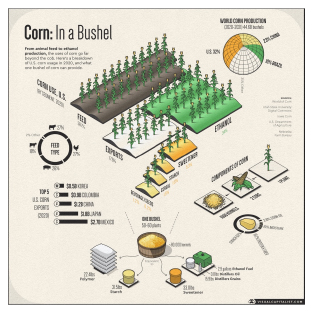
Corn
Corn, or maize (Zea mays), originated in southern Mexico, where it was first domesticated approximately 9,000 years ago from a wild grass called teosinte (Zea mays ssp. parviglumis). Once domesticated, corn spread rapidly through the Americas as people shared seeds with each other, often becoming as important spiritually as nutritionally. For many, corn is much more than a staple food. Among some Maya-speaking peoples of Central America, creation stories say that human flesh was first made of maize dough, and that all parts of the plant are both useful and sacred.
Science & Environment
Breaking It Down
Nixtamalization is an ancient method of making tough corn kernels edible and nutritious. Invented by Indigenous Mesoamerican peoples thousands of years ago, this process applies an alkaline solution such as ashes or lime (calcium hydroxide) mixed with water to corn. The lime helps break down corn’s tough exterior, making nutrients such as vitamin B3 (niacin) and protein easier to absorb by the human body.
Nixtamalized corn, which may be familiar as hominy or masa, is the core ingredient in tortillas, tamales, and pozole.
Taste & Nutrition
Sweet Spot
Thanks to genetic science, the corn we eat today is sweeter in taste than corn of even the recent past. In the 1950s, American botanist John Laughnan discovered that a certain gene in corn could make kernels more than four times sweeter with a creamier texture. In the 1970s, the discovery of a second gene called sugary enhancer1 increased the sweetness of corn even more. These modifications caught on; today sweet corn is the main type of fresh, unprocessed corn eaten by U.S. consumers.
Fields of Gold
Today, corn is the most commonly grown crop in the United States, though an overwhelming majority—at least two-thirds of the crop—goes toward animal feed and ethanol. The remaining approximate 12% is processed into oils, high fructose corn syrup, and a very small amount that is eaten fresh.
Of all corn grown in the U.S., about 92% is made up of genetically modified varieties, and requires large inputs of nitrogen fertilizers to grow. Most non-GMO plants cannot tolerate this much nitrogen, and over time nitrogen pollution can reduce wildlife diversity and harm plant health in local ecosystems.

Lend Me an Ear (of Corn)
Check out these fun facts about corn!
- There is an even number of rows in every cob of corn.
- In the 1800s, when coffee was too expensive and scarce, people used parched corn as a coffee substitute.
- Corn is used in a variety of non-food-based products, such as fireworks, paper, shoe polish, and detergent!
Corn can be incorporated into your meals in many ways. Here are some recipes to try and share with us using #AroundTheTable!